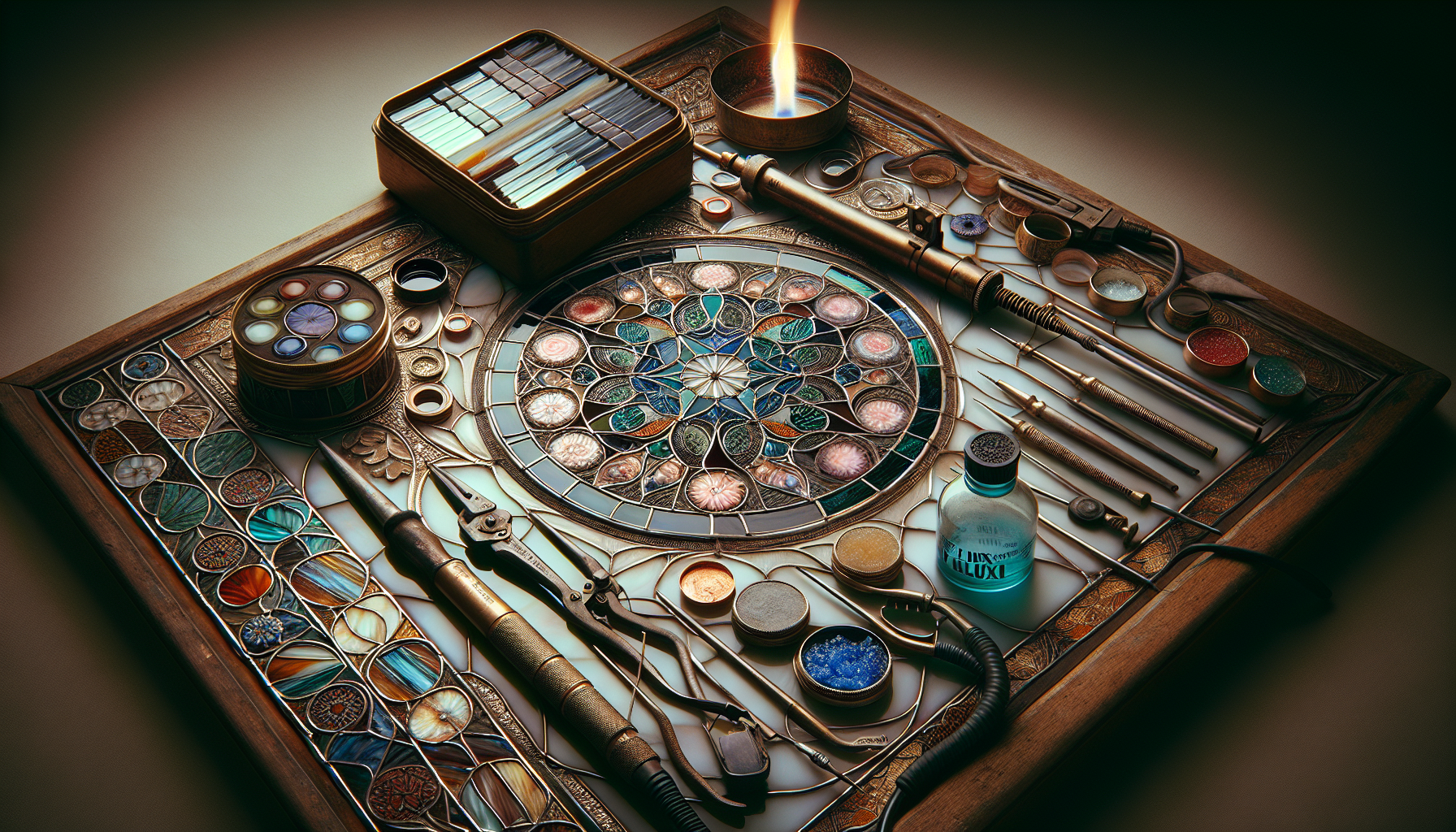Do You Need Flux To Solder Stained Glass?
So, you’re getting into the art of stained glass, and you’re wondering if you need to use flux when soldering? Well, fret no more – we’re here to provide some clarity! In this article, we’ll explore the importance of flux in the soldering process for stained glass and why it’s a crucial tool to ensure strong and durable joints. Whether you’re a seasoned stained glass artist or just starting out, this article will shed light on the significance of flux and how it can enhance your soldering experience. So let’s dive right in and uncover the secrets of flux in soldering stained glass!

What is flux?
Definition
Flux is a chemical compound that is vital in the process of soldering, including soldering stained glass. It is a material that is applied to the metal surface before soldering to ensure a smooth and strong bond between the metal and the solder.
Purpose
The main purpose of flux is to prevent oxidation, clean the metal surface, promote the smooth flow of solder, and ultimately help create strong bonds between the pieces of stained glass. It plays a crucial role in achieving high-quality and long-lasting soldered joints in stained glass projects.
Types of flux
There are various types of flux available for soldering stained glass, each with its own unique properties and uses. Some common types of flux include liquid flux, paste flux, and self-cleaning flux. Each type has its advantages and disadvantages, and the choice of flux will depend on the specific needs of your soldering project.
Flux in stained glass soldering
Importance of flux
Flux is essential in stained glass soldering because it helps ensure a successful soldered joint. Without flux, the solder might not adhere properly to the metal surface, leading to weak or uneven joints. In stained glass soldering, where the strength and durability of the soldered connections are crucial, using flux becomes even more important.
How flux works in stained glass soldering
When flux is applied to the metal surface, it creates a barrier between the metal and the surrounding atmosphere. This barrier prevents oxidation and helps protect the metal from contaminants that can hinder solder flow. Additionally, flux acts as a cleaning agent, removing any dirt, grease, or oxidation from the metal surface, allowing the solder to bond effectively.
Benefits of using flux
Using flux in stained glass soldering offers numerous benefits. It ensures a clean metal surface, reduces the risk of oxidation, promotes the smooth flow of solder, and ultimately leads to stronger and more reliable soldered joints. Flux also helps create a visually appealing soldered seam by preventing discoloration and promoting a more professional finish.
The role of flux in soldering stained glass
Prevents oxidation
One of the primary roles of flux in stained glass soldering is to prevent oxidation. When exposed to air, the metal surfaces can quickly oxidize, forming a layer of oxide that inhibits the solder’s ability to bond with the metal. Flux creates a protective coating that prevents oxidation, allowing the solder to adhere properly and form a strong bond.
Cleans the metal surface
In addition to preventing oxidation, flux also acts as a cleaning agent. It removes any dirt, grease, or oxidation present on the metal surface, ensuring a clean and pristine working area. By removing these contaminants, flux helps improve the quality of the soldered joint and promotes better adhesion between the metal and the solder.
Promotes smooth flow of solder
Flux plays a crucial role in enabling the solder to flow smoothly across the metal surface. It reduces the surface tension of the solder, making it easier to apply and ensuring a consistent coverage. This smooth flow of solder helps create even and reliable soldered joints in stained glass projects.
Helps in creating strong bonds
By preventing oxidation, cleaning the metal surface, and promoting the smooth flow of solder, flux ultimately helps create strong bonds between the pieces of stained glass. These strong bonds not only enhance the structural integrity of the project but also contribute to its overall aesthetic appeal. By using flux in stained glass soldering, you can achieve professional-looking results that will withstand the test of time.
Choosing the right flux for soldering stained glass
Considerations while selecting flux
When selecting flux for soldering stained glass, it is important to consider factors such as the type of metal being soldered, the desired outcome, and personal preferences. Some fluxes are specifically designed for use with certain types of metals, while others offer more versatility. It is crucial to choose a flux that is compatible with the materials you are working with to ensure optimal results.
Types of flux for stained glass soldering
There are several types of flux available for soldering stained glass, each with its own characteristics and uses. Liquid flux is commonly used for general stained glass soldering projects due to its convenience and ease of application. Paste flux, on the other hand, is thicker and offers more control when applying to specific areas. Self-cleaning flux is especially useful when soldering larger or more complex stained glass projects, as it helps prevent the buildup of oxidation and residue.
Pros and cons of different flux options
Each type of flux has its pros and cons. Liquid flux, for example, is easy to apply and provides a thin and even coating, but it may evaporate quickly or drip if not applied carefully. Paste flux, on the other hand, offers more control and longevity, but it can be messier to work with. Self-cleaning flux is convenient for larger projects, but it may also leave residue that requires additional cleaning. It is important to consider these factors and choose the flux that best suits your specific soldering needs.

Using flux in stained glass soldering
Applying flux to the soldering area
To properly use flux in stained glass soldering, it should be applied to the metal surface that will be soldered. This can be done by using a small brush or applicator to evenly spread the flux over the entire soldering area. It is important to apply a thin and even layer of flux, ensuring that all surfaces are adequately coated.
Techniques for using flux
Once the flux is applied, the stained glass pieces can be positioned and held together with copper foiling or another suitable method. Then, the soldering iron is heated, and the solder is applied to the flux-coated areas. The flux acts as a catalyst, facilitating the bonding process between the metal and the solder.
Tips for effective use of flux
To ensure the best results when working with flux in stained glass soldering, there are several tips to keep in mind. It is important to use the appropriate amount of flux – too little may not provide adequate protection, while too much may cause excessive residue. Additionally, flux should be applied only to the areas that will be soldered, avoiding contact with the glass itself. It is also recommended to periodically clean the soldering iron tip and reapply flux as needed during the soldering process.
Alternatives to flux in stained glass soldering
Flux-free soldering techniques
While flux is commonly used in stained glass soldering, there are alternative techniques that can be used without the need for flux. One such technique is using self-fluxing solder, which contains flux within the solder itself. Another option is to use a flux substitute, such as homemade borax flux. However, it is important to note that these alternative techniques may not provide the same level of protection against oxidation as traditional flux.
When to consider alternatives to flux
Alternatives to flux may be considered in situations where traditional flux is not readily available or when working on smaller or less complex stained glass projects. However, it is important to remember that these alternatives may have limitations and may not achieve the same level of quality and durability as working with traditional flux.
Common myths about flux in soldering stained glass
Flux is unnecessary
One common myth is that flux is unnecessary in stained glass soldering. However, this myth is incorrect. Flux plays a vital role in ensuring proper adhesion between the metal and the solder, preventing oxidation, and promoting the flow of solder. Without flux, the soldered joints may be weak, uneven, or prone to oxidation.
Flux is harmful to the glass
Another myth is that flux is harmful to the glass. This is not true, as long as the flux is applied only to the metal surface and not directly onto the glass. Flux is primarily used to protect the metal and facilitate solder flow, and when used correctly, it poses no harm to the glass.
Flux is difficult to use
Some may believe that using flux is difficult or complicated. However, with proper guidance and practice, using flux in stained glass soldering can become a straightforward and effective process. It is important to familiarize yourself with the different types of flux available and follow recommended techniques and safety precautions to achieve the best results.
Tips for working with flux in stained glass soldering
Practice safety precautions
When working with flux in stained glass soldering, it is essential to prioritize safety. Flux may contain chemicals that can be harmful if ingested or come into contact with the skin or eyes. It is important to wear protective gloves and eyewear, work in a well-ventilated area, and follow the manufacturer’s instructions for safe handling and disposal of the flux.
Proper storage and handling
To ensure the longevity and effectiveness of your flux, proper storage and handling are crucial. It is best to store flux in a cool, dry place, away from direct sunlight and extreme temperatures. Make sure the container is tightly sealed to prevent the flux from drying out or becoming contaminated.
Cleaning up flux residues
After completing the soldering process, it is important to clean up any flux residues. Flux residues left on the soldered joints can potentially corrode over time, compromising the integrity of the soldered connections. A soft brush or cloth dampened with water can be used to remove any excess flux, ensuring a clean and visually appealing finish.
Conclusion
Flux is an essential component in the process of soldering stained glass, offering numerous benefits and playing a crucial role in achieving strong and reliable soldered joints. Its ability to prevent oxidation, clean the metal surface, promote the smooth flow of solder, and create strong bonds makes it an indispensable tool for any stained glass artist. By understanding the different types of flux available, properly applying flux, and following recommended techniques, you can enhance your stained glass soldering skills and create beautiful, durable stained glass pieces. Remember to prioritize safety when working with flux, practice proper handling and storage, and clean up flux residues for optimal results.


